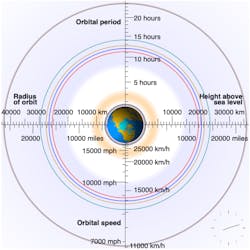We’ve seen quite a bit of confusion when it comes to which timing device works best in satellite-communication applications. Should you use a standard oscillator, GPS Disciplined Oscillator (GPSDO), or atomic clock (cesium and rubidium) in your satellite application?
Of course, the short answer is "it depends.” The choice of timing device depends on the specific needs, limitations, and operational orbit. Let's take a look at the use of standard oscillators, GPSDOs, atomic clocks (rubidium and cesium), and chip-scale atomic clocks (CSACs) for different satellite design requirements.
LEO Satellite Applications
Let’s start by discussing the satellites closest to earth: low-earth-orbit (LEO) satellites. LEO satellites operate at an altitude of 2,000 km or less. This close proximity to Earth's atmosphere results in shorter operational life and lower cost requirements. One advantage of LEO satellites is that they can receive precision timing from Global Navigation Satellite Systems (GNSS) satellites.
The Benefits of GPSDOs in Low Earth Orbits
Some atomic clocks provide great low-power and stability benefits. However, it's a misguided belief in the LEO satellite industry that an atomic clock's precision timing always justifies the higher size, weight, power, and cost (SWaP-C). Since Global Positioning System (GPS) signals come from medium-earth-orbit (MEO) satellites, GPSDOs are a more popular precision timing solution than traditional atomic clocks.
GPSDOs offer reduced SWaP-C compared to atomic clocks. Thus, GPSDOs are usually a better and more cost-effective solution for LEO satellites that have shorter design life than traditional deep-space missions.
Alternatively, many low-power oven-controlled crystal oscillators (OCXOs) can provide precision timing with good stability and phase noise at a lower cost. Bliley's line of specially designed LEO precision time and frequency products can withstand the radiation environments found in LEO space.
MEO Satellite Applications
MEO satellites operate at an altitude between 2,000 and 35,786 km. This is the region of space occupied by GNSS satellites. MEO satellites have a longer design life than LEO satellites, but they do not require the highly engineered designs needed for GEO space.
It’s important to note that a precision atomic clock timing source (like the AR133 series rubidium atomic clock) coupled with an ultra-stable oscillator (using the legacy BG61/BQOTY crystal) is required at this orbit.
Geostationary Orbit (GEO) Satellite Applications
GEO satellites operate at an altitude of 35,786 km. This high altitude requires larger launch vehicles and longer design life than LEO or MEO satellites. The high altitude also makes GPS signals unavailable.
As is the case with medium earth orbit, a precision atomic clock (like the AR133 series rubidium atomic clock) timing source coupled with an ultra-stable oscillator (using the legacy BG61/BQOTY crystal) is required at geostationary orbit.
Other Timing Solutions
There are newer, innovative timing solutions that are revolutionizing small satellite communications, such as new GPSDO timing solutions specifically designed for LEO satellite applications. These GPSDO solutions are perfect for applications like tracking, communication, and earth observation with small satellites, cube satellites, and LEO satellites.


